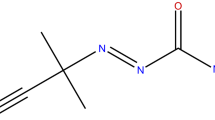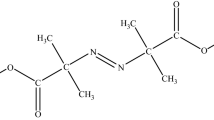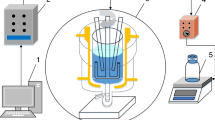Abstract
Azobisisobutyronitrile (AIBN), an azo compound, is widely used in the polymerization reaction process. Due to –N = N– composition of AIBN, it has excellent high thermal sensitivity and decent amounts of decomposition heat. When the cooling system fails, a runaway reaction may occur, leading to a fire or explosion. We used differential scanning calorimetry (DSC) to analyze the thermal hazard parameters of AIBN. Based on DSC thermal data, we can determine the apparent onset temperature (T 0), heat of decomposition (ΔH d), apparent activation energy (E a) and its reaction model to evaluate the basic thermal hazard of AIBN. We evaluated the critical runaway parameters of AIBN by Semenov methods, such as critical runaway temperatures and stable temperatures. These critical runaway parameters can be used to describe the unstable reaction criterion, which could determine AIBN’s thermal criticality. These results are able to prevent the thermal hazard and runaway during the production, transportation, and storage of AIBN.








Similar content being viewed by others
Abbreviations
- R :
-
Gas constant (8.31415 J K−1 mol−1)
- A :
-
Pre-exponential factor of Arrhenius equation (min−1)
- C o :
-
Original concentration of the material (g cm−3)
- C :
-
Concentration of the material (g cm−3)
- C p :
-
Specific heat of material (J g−1 K−1)
- E a :
-
Apparent activation energy (kJ mol−1)
- h :
-
Heat exchange capability index of the cooling system (kJ m−2 K−1min−1)
- k :
-
Reaction rate constant (dimensionless)
- n :
-
Reaction order (dimensionless)
- m :
-
Mass of material (g)
- ΔH d :
-
Heat of decomposition (J g−1)
- ΔH t :
-
Heat of decomposition at time (J g−1)
- ΔH total :
-
Total heat of decomposition (J g−1)
- –r :
-
Reaction rate (mol L−1 s−1)
- q g :
-
Heat production rate (kJ min−1)
- q r :
-
Heat discharge rate (kJ min−1)
- q r1 :
-
Heat discharge rate by high cooling medium (kJ min−1)
- q r2 :
-
Heat discharge rate by cooling system (kJ min−1)
- q r3 :
-
Heat discharge rate by low cooling system (kJ min−1)
- S :
-
Effective heat exchange area (m2)
- T :
-
Process temperature (K)
- T 0 :
-
Apparent exothermic temperature (K)
- T P :
-
Temperature at the maximum heat release in reaction (K)
- T a :
-
Surroundings temperature under cooling system (K)
- T a (tr) :
-
Surroundings temperature under cooling system at transitional point (K)
- T S :
-
Temperature at the steady state, which occurs at the intersection point of curves q g and q r
- t :
-
Reaction time (min)
- t p :
-
Transitional point (K)
- T CI :
-
Critical ignition or extinction temperature (K)
- T FCE :
-
Final critical extinguish temperature (K)
- T C (tr) :
-
Final critical ignition or extinguish temperature at transitional point (K)
- T FSE :
-
Final stable point of extinguish temperature (K)
- TFSI :
-
Final stable point of ignition temperature (K)
- T FSL :
-
Stable point at low temperatures (K)
- T FSH :
-
Stable point at higher temperatures (K)
- T M :
-
Cutoff point between curves q g and q r at the highest and lowest cooling efficient system (K)
- V :
-
Volume of process instruments (m3)
- X A :
-
Fractional conversion (dimensionless)
- ρ :
-
Density of material (g cm−3)
References
Liu SH, Yu YP, Lin YC, Weng SY, Hsieh TF, Hou HY. Complex thermal evaluation for 2, 20-azobis (isobutyronitrile) by non-isothermal and isothermal kinetic analysis methods. J Therm Anal Calorim. 2013;112:1361–7.
Roduit B, Hartmann M, Folly P, Sarbach A, Brodard P, Baltensperger R. Determination of thermal hazard from DSC measurements. Investigation of self-accelerating decomposition temperature (SADT) of AIBN. J Therm Anal Calorim. 2014;117:1017–26.
Lin CP, Tseng JM, Chang YM, Liu SH, Cheng YC, Shu CM. Modeling liquid thermal explosion reactor containing tert-butyl peroxybenzoate. J Therm Anal Calorim. 2010;102:587–9.
You ML, Tseng JM, Liu MY, Shu CM. Runaway reaction of lauroyl peroxide with nitric acid by DSC. J Therm Anal Calorim. 2010;102:535–9.
Luo KM, Chang JG, Lin SH, Chang CT, Yeh TF, Hu KH, Kao CS. The criterion of critical runaway and stable temperatures in cumene hydroperoxide reaction. J Loss Prev Process Ind. 2001;14:229–39.
Tsai YT, You ML, Qian XM, Shu CM. Calorimetric techniques combined with various thermokinetic models to evaluate incompatible hazard of tert-butyl peroxy-2-ethyl hexanoate mixed with metal ions. Ind Eng Chem Res. 2013;52:8206–15.
Lu KT, Luo KM, Lin PC, Hwang KL. Critical runaway conditions and stability criterion of RDX manufacture in continuous stirred tank reactor. J Loss Prev Process Ind. 2005;18:1–11.
Li XR, Wang XL, Koseki H. Study on thermal decomposition characteristics of AIBN. J Hazard Mater. 2008;159:13–8.
Boswell PG. On the calculation of activation energies using a modified Kissinger method. J Therm Anal Calorim. 1980;18:353–8.
Marco E, Cuartielles S, Pen˜a JA, Santamaria J. Simulation of the decomposition of di-cumyl peroxide in an ARSST unit. Thermochim Acta. 2002;362:49–58.
Snee TJ, Barcons C, Hernandez H, Zaldivar JM. Characterisation of an exothermic reaction using adiabatic and isothermal calorimetry. J Therm Anal Calorim. 1992;38:2729–47.
Li XR, Koseki H. SADT prediction of autocatalytic material using isothermal calorimetry analysis. Thermochim Acta. 2005;431:113–6.
Carmona VB, Oliveira RM, Silva WTL, Mattoso LHC, Marconcini JM. Nanosilica from rice husk: extraction and characterization. Ind Crop Prod. 2013;43:291–6.
Bartknecht W. Explosions: course, prevention, and protection. New York: Springer; 1981.
Semenov NN. Thermal theory of combustion and explosion. Usp Fiz Nauk. 1940;23:4–17.
Semenov NN. Zur theorie des verbrennungsprozesses. Z Phys Chem. 1928;48:571–3.
Morbidelli M, Varma A. A generalized criterion for parametric sensitivity: application to thermal explosion theory. Chem Eng Sci. 1988;43:91–8.
Wu SH. Runaway reaction and thermal explosion evaluation of cumene hydroperoxide (CHP) in the oxidation process. Thermochim Acta. 2013;559:92–7.
Eigenberger G, Schuler H. Reactor stability and safe reaction engineering. Int Chem Eng. 1989;29:12–9.
Villermaux J, Georgakis C. Current problems concerning batch reactions. Int Chem Eng. 1991;31:434–41.
Lee RY, Hou HY, Tseng JM, Chang MK, Shu CM. Reaction hazard analysis for the thermal decomposition of cumene hydroperoxide in the presence of sodium hydroxide. J Therm Anal Calorim. 2008;93:269–70.
Wu KW, Hou HY, Shu CM. Thermal phenomena studies for dicumyl peroxide at various concentrations by DSC. J Therm Anal Calorim. 2006;83:41–4.
Kohlbrand HT. The use of SimuSolv in the modeling of ARC (accelerating rate calorimeter) data, International symposium on runaway reactions. New York: AIChE; 1989. p. 86–111.
Lu KT, Yang CC, Lin PC. The criteria of critical runaway and stable temperatures of catalytic decomposition of hydrogen peroxide in the presence of hydrochloric acid. J Hazard Mater. 2006;135:319–27.
Lu KT, Luo KM, Lin SH, Su SH, Hu KH. The acid-catalyzed phenol–formaldehyde reaction: critical runaway conditions and stability criterion. Process Saf Environ Prot. 2004;82:37–47.
Author information
Authors and Affiliations
Corresponding author
Rights and permissions
About this article
Cite this article
Tsai, YT., Cao, CR., Chen, WT. et al. Using calorimetric approaches and thermal analysis technology to evaluate critical runaway parameters of azobisisobutyronitrile. J Therm Anal Calorim 122, 1151–1157 (2015). https://doi.org/10.1007/s10973-015-4982-5
Received:
Accepted:
Published:
Issue Date:
DOI: https://doi.org/10.1007/s10973-015-4982-5




